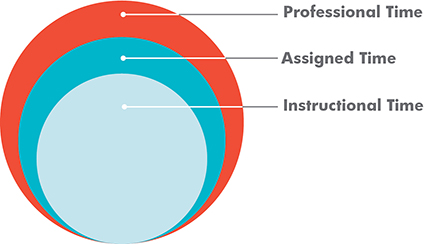Page Content
 Did you know that instructing students makes up only about half of a teacher’s regular work day?
Did you know that instructing students makes up only about half of a teacher’s regular work day?
This is just one of the very interesting insights learned from the comprehensive Alberta Teacher Workload Study released last spring. This intensive study tracked the working hours of more than 1,500 teachers and 110 school administrators through the course of the 2014/15 school year.
The study found that, in a regular work week, teachers work an average of 48 hours, including an average of seven hours outside of the regular school day (defined in the study as 8 a.m. to 4:30 p.m.) and 3.4 hours on weekends. Not included in that number is the time put in over holiday periods, including an average of 72 hours in the summer. Of course, administrators log even more time than that.
We’ve all had the conversation with a neighbour or uncle about how little teachers work, when they say you only work about six hours a day and get 12 weeks off each year.
Well, the Alberta Teacher Workload Study provides a clear indication that, over the course of a full year, teachers work a similar number of hours (2016) as other professionals. But I am quite convinced that these neighbours and uncles of ours aren’t going to care much about how long we work. Albertans are hard-working people and many people work long hours. I do, however, think they will care about how we spend our time working.
It’s easy for the regular Joe or Jane Albertan to create a picture of what teachers do all day. After all, everyone has spent considerable time in a teacher’s workplace — no other job is like that in this regard. But if we talked more about the fact that less than half of our working time is spent in the classroom, we might surprise some people.
We in Teacher Welfare have come up with a model for how we can talk about teacher time.
This model involves three nested circles. The smallest one, representing 50 per cent of the total area, is labelled “instructional time.”

The next circle is “assigned time.” This circle includes all the time teachers spend working on stuff assigned by their employers. It includes the time spent instructing students, but it also includes activities like lunch and recess supervision, parent–teacher interviews, staff meetings, board-directed inservicing and mandated collaboration time. According to the workload study, this circle amounts to a total of about 75 per cent of teachers’ time.
Finally, the outermost circle is described as “professional time.” Teachers’ professional time includes all the instructional and other assigned duties but also all the work required to fulfill their obligations as professionals. This includes lesson planning and preparation, assessment design, development and marking, communicating with parents, and consulting with colleagues and other professionals, as well as self-directed professional development.
By describing our work life in this way, we can begin to change the conversations we have with that pesky neighbour or uncle — and even with others who might be more supportive and sympathetic. We can change the conversation by talking about how the heart and joy of our work is the instructional time, the time spent directly on student learning. But we can also talk about how we need professional time to properly support students’ instructional needs and ensure that the instructional time is used effectively.
Finally, we can talk about how lately our professional time is being squeezed by an increasingly expanding assigned time circle. Many activities and tasks are being assigned to us by school boards and are getting in the way of our ability to spend time on the activities that are required to support the classroom.
In this way, we shift the conversation. It’s not about teachers wanting to do less; it’s about teachers wanting to do more of the things that actually matter to learning.
This should resonate with parents and others who care about the quality of instruction that students receive. Public opinion polling done by the Association this past June found that more than three-quarters of Albertans agreed that addressing teachers’ workloads would improve public education in Alberta.
But to achieve the necessary improvements, we need to start by expanding the general public’s understanding of what teacher work looks like, and that begins with the use of some common language.
So, the next time your uncle starts in about how little teachers work, respond by talking about how less than half of your time is spent in the classroom and how you would love to have more professional time to support the work done there.❚
